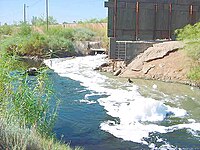
Photo from wikipedia
Abstract Bioretention systems are increasingly used worldwide to mitigate the impacts of urban stormwater runoff on the water cycle. Being able to accurately model physical processes occurring within these systems… Click to show full abstract
Abstract Bioretention systems are increasingly used worldwide to mitigate the impacts of urban stormwater runoff on the water cycle. Being able to accurately model physical processes occurring within these systems is critical to their design and to being able to predict their performance. Most popular urban hydrological models must now integrate a low impact development (LID) toolbox to keep up with current practices. We aimed to develop and test a generic model of bioretention systems that can serve as a targeted compromise between oversimplification without any physical basis, on the one hand, and physical soundness requiring a large number of parameters for calibration, on the other. The model accounts for evapotranspiration, overflow, infiltration into the filter (single permeability behavior), exfiltration to surrounding soils, along with underdrain discharge. The model was tested against field data from a monitored bioretention basin in Melbourne, Australia. Based on 22 rainfall events (two used for calibration and 20 for validation), results showed that the simulated underdrain outflow rates and their temporal dynamic were well replicated (considering the validation phase with 20 rainfall events: median NSE = 0.75, median PBIAS = −22%, median RMSE = 0.48 l/s). Despite good performance for outflow rates, there was a discrepancy observed in magnitude between simulated and measured water levels within the bioretention basin. The model therefore seems a useful first step towards the design of a user-friendly model for assessing both performance and impact of bioretention basins for catchment-scale flow regime management.
Journal Title: Journal of Cleaner Production
Year Published: 2021
Link to full text (if available)
Share on Social Media: Sign Up to like & get
recommendations!